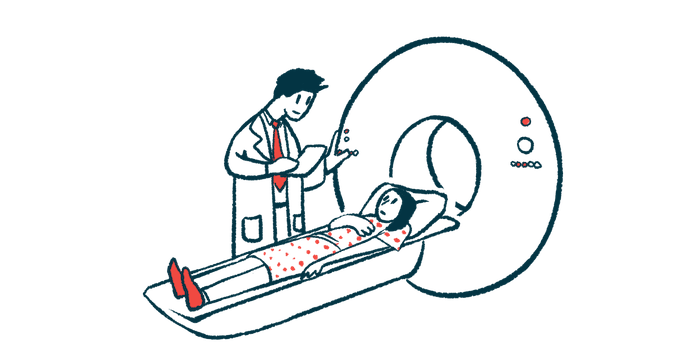Widespread Brain Volume Loss in Sheep With CLN5, CLN6 Disease
Atrophy marked by loss of gray matter, increase in cerebrospinal fluid

Longitudinal MRI imaging in naturally-occurring sheep models of CLN5 and CLN6 disease — two types of Batten disease — revealed early and progressive brain volume loss, a study showed.
A feature of this atrophy was the loss of gray matter and an increase in volume of the cerebrospinal fluid (CSF) that surrounds the brain and spinal cord. Both were associated with more severe disease symptoms.
The disease-related brain atrophy affected different brain regions at different times and with different force, adding to an “understanding of the selective vulnerability and timeline of degeneration of specific brain regions,” the researchers wrote in the study, “Progressive MRI brain volume changes in ovine models of CLN5 and CLN6 neuronal ceroid lipofuscinosis,” which was published in Brain Communications.
The findings point to “regions of interest for monitoring in current clinical trials of gene therapy … in humans that are using MRI as an outcome measure for assessing therapeutic efficacy,” they wrote.
Batten disease, also known as neuronal ceroid lipofuscinosis (NCL), encompasses a group of rare genetic diseases marked by vision loss, motor and cognitive declines, behavioral changes, and seizures. It’s caused by mutations in any of more than a dozen CLN genes that lead to waste molecules accumulating to toxic levels in cells, particularly affecting the brain.
What do Brain MRI scans show?
MRI scans in Batten patients show progressive brain atrophy, notably in the cortex — the outermost layer involved in higher-level brain functions — but also in other regions, such as the cerebellum, which is involved in motor control.
An enlargement of the brain’s ventricles, the CSF-filled spaces deep in the brain, and reduced activation of the thalamus, which works as a relay center, have also been observed.
Naturally-occurring sheep models of two Batten types — CLN5 and CLN6 disease —have been used extensively to study various aspects of the disease. CLN5 disease is caused by mutations in the CLN5 gene, while CLN6 disease is linked to CLN6 gene mutations. These models exhibit symptoms of the human disorder, including progressive blindness, cognitive decline, brain atrophy, and neuroinflammation.
Brain MRI scans in these sheep models tracked the overall and regional brain volume changes over time. The findings were “expected to inform on potential target areas for treatment,” the researchers wrote.
The sheep’s brains were examined at 5 months of age (before symptom onset) at 7 months (early symptoms), 10 and 14 months (advanced disease), and 18 months (late-stage disease).
Healthy sheep who also had brain MRI scans served as controls. Monthly symptom assessments were conducted using the Ovine Batten Disease Rating Scale.
CLN5, CLN6 models show brain volume loss
The CLN5 disease model exhibited a significantly lower brain volume compared with healthy sheep at 5 months with brain volume beginning to notably decline at 14 months.
A similar pattern was seen in the CLN6 disease sheep, although accelerated brain volume declines were seen at around 7 months.
In both models, brain atrophy appeared to be mostly driven by a progressive loss of gray matter, the brain tissue containing nerve cell bodies, and accompanied by CSF volume increases.
White matter, the brain tissue containing mostly nerve cell projections, or axons, was also lost in the sheep, but declines generally occurred later and at a slower rate.
Gray matter “appears to be more vulnerable to degeneration earlier and at a faster rate than [white matter] in ovine NCL,” the researchers wrote, adding “this may be due to the initial loss of neuronal cell bodies and subsequent degeneration of axonal fibers.”
The progressive loss of brain tissue was generally observed in all areas of the cortex, but the parieto-occipital and visual cortices were the most severely affected. Both are involved in vision, consistent with the progressive blindness that marks Batten. Other regions outside the cortex appeared to be relatively spared, including the cerebellum, which contrasts with observations made in Batten patients.
“The reason for the lack of cerebellar [damage] in CLN5 and CLN6 sheep is unknown, however may manifest if affected sheep were studied beyond the humane endpoint of 18–24 months of age,” the researchers wrote.
The caudate nucleus, a region involved in a number of high-level neurological functions, showed rapid atrophy in the end-stages of the CLN5 model.
In both models, reduced gray matter and higher CSF volumes were each strongly associated with more severe symptoms.
“While previous studies of affected sheep brain tissue have demonstrated which regions are most significantly degenerated at end-stage disease, the current study provides a time course of this degeneration and shows that many affected cortical regions … are already significantly atrophied before the onset of symptoms,” the researchers wrote.
The early and generalized brain tissue loss support an early treatment that could be distributed throughout the brain, such as a gene therapy injected directly into the ventricles, the researchers said, adding their findings “established a benchmark” for assessing the therapeutic effectiveness of gene therapy trials in both NCL sheep models that can be translated to human medicine.







